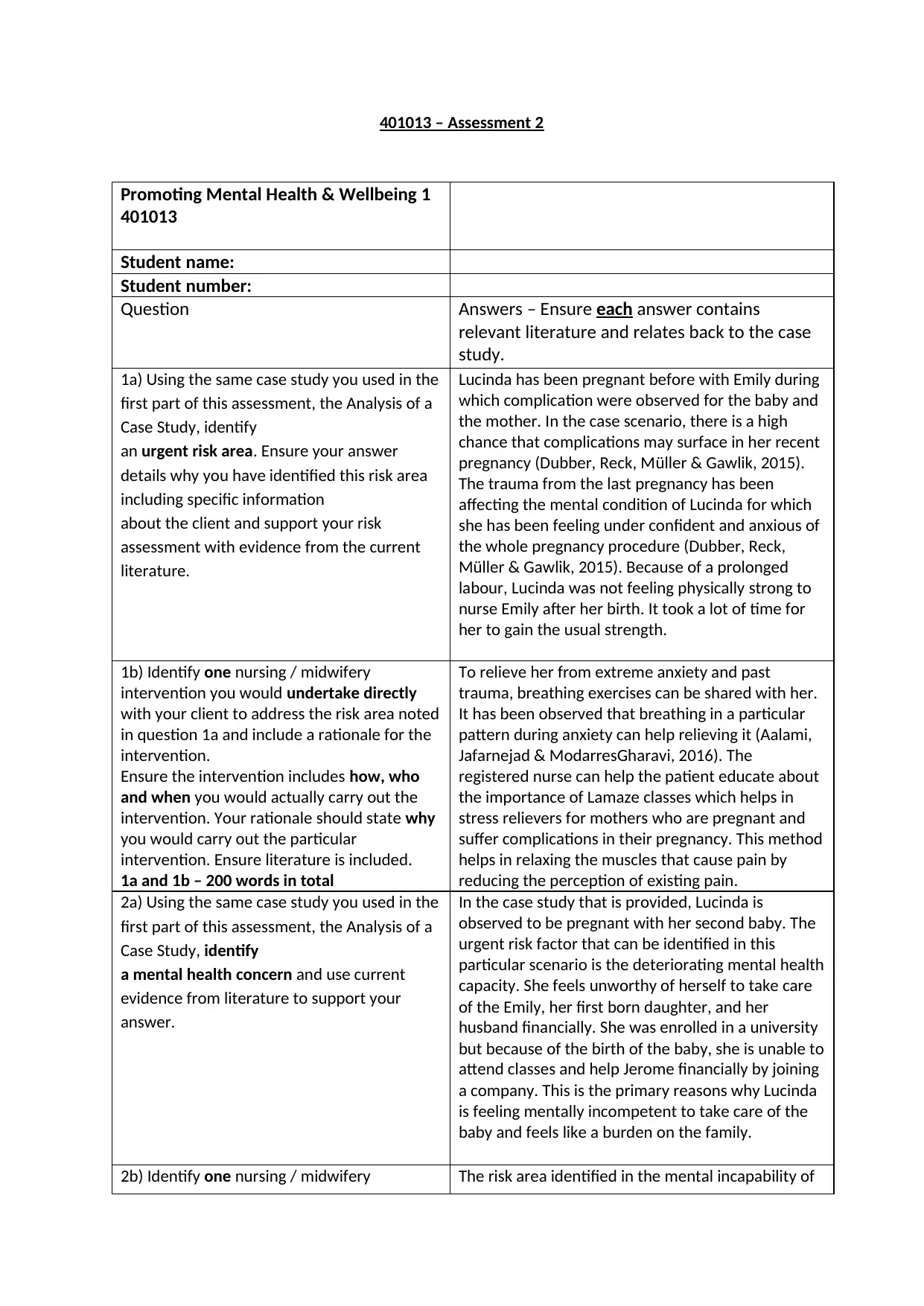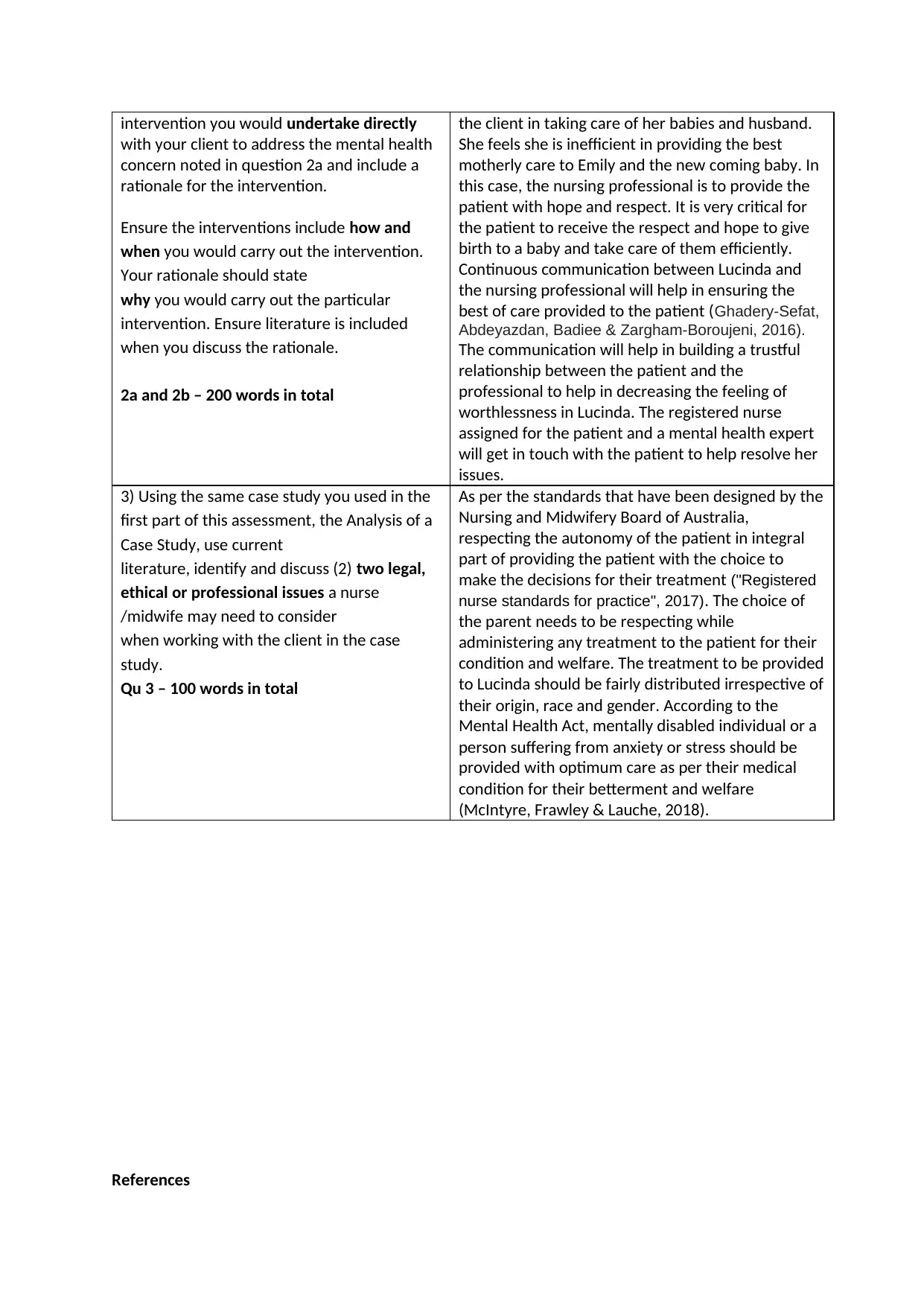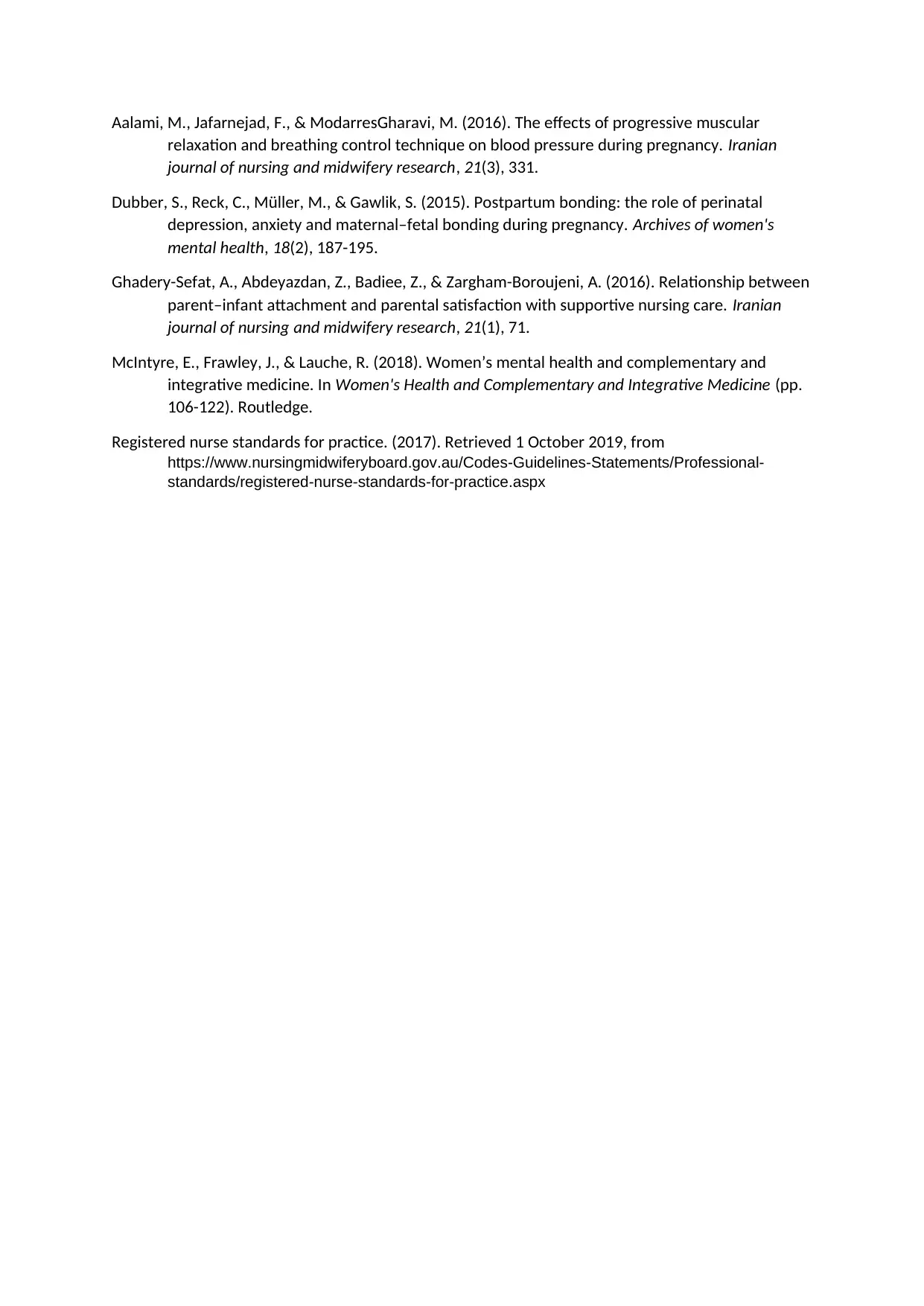Western Sydney University: 401013 Mental Health Report
VerifiedAdded on 2022/10/04
|3
|1195
|107
Report
AI Summary
This report presents an analysis of a mental health case study, focusing on a pregnant woman named Lucinda experiencing anxiety and potential complications related to her pregnancy. The assignment identifies urgent risk areas, such as the potential for complications and the impact of past trauma on her mental state, supported by current literature. It proposes specific nursing and midwifery interventions, including breathing exercises and Lamaze classes, with detailed rationales. Furthermore, the report addresses mental health concerns, like Lucinda's feelings of inadequacy, and suggests interventions such as providing hope and continuous communication. The report also explores legal, ethical, and professional issues, such as respecting patient autonomy and providing fair treatment. All findings are supported by relevant literature, adhering to the Nursing and Midwifery Board of Australia standards and the Mental Health Act.

401013 – Assessment 2
Promoting Mental Health & Wellbeing 1
401013
Student name:
Student number:
Question Answers – Ensure each answer contains
relevant literature and relates back to the case
study.
1a) Using the same case study you used in the
first part of this assessment, the Analysis of a
Case Study, identify
an urgent risk area. Ensure your answer
details why you have identified this risk area
including specific information
about the client and support your risk
assessment with evidence from the current
literature.
Lucinda has been pregnant before with Emily during
which complication were observed for the baby and
the mother. In the case scenario, there is a high
chance that complications may surface in her recent
pregnancy (Dubber, Reck, Müller & Gawlik, 2015).
The trauma from the last pregnancy has been
affecting the mental condition of Lucinda for which
she has been feeling under confident and anxious of
the whole pregnancy procedure (Dubber, Reck,
Müller & Gawlik, 2015). Because of a prolonged
labour, Lucinda was not feeling physically strong to
nurse Emily after her birth. It took a lot of time for
her to gain the usual strength.
1b) Identify one nursing / midwifery
intervention you would undertake directly
with your client to address the risk area noted
in question 1a and include a rationale for the
intervention.
Ensure the intervention includes how, who
and when you would actually carry out the
intervention. Your rationale should state why
you would carry out the particular
intervention. Ensure literature is included.
1a and 1b – 200 words in total
To relieve her from extreme anxiety and past
trauma, breathing exercises can be shared with her.
It has been observed that breathing in a particular
pattern during anxiety can help relieving it (Aalami,
Jafarnejad & ModarresGharavi, 2016). The
registered nurse can help the patient educate about
the importance of Lamaze classes which helps in
stress relievers for mothers who are pregnant and
suffer complications in their pregnancy. This method
helps in relaxing the muscles that cause pain by
reducing the perception of existing pain.
2a) Using the same case study you used in the
first part of this assessment, the Analysis of a
Case Study, identify
a mental health concern and use current
evidence from literature to support your
answer.
In the case study that is provided, Lucinda is
observed to be pregnant with her second baby. The
urgent risk factor that can be identified in this
particular scenario is the deteriorating mental health
capacity. She feels unworthy of herself to take care
of the Emily, her first born daughter, and her
husband financially. She was enrolled in a university
but because of the birth of the baby, she is unable to
attend classes and help Jerome financially by joining
a company. This is the primary reasons why Lucinda
is feeling mentally incompetent to take care of the
baby and feels like a burden on the family.
2b) Identify one nursing / midwifery The risk area identified in the mental incapability of
Promoting Mental Health & Wellbeing 1
401013
Student name:
Student number:
Question Answers – Ensure each answer contains
relevant literature and relates back to the case
study.
1a) Using the same case study you used in the
first part of this assessment, the Analysis of a
Case Study, identify
an urgent risk area. Ensure your answer
details why you have identified this risk area
including specific information
about the client and support your risk
assessment with evidence from the current
literature.
Lucinda has been pregnant before with Emily during
which complication were observed for the baby and
the mother. In the case scenario, there is a high
chance that complications may surface in her recent
pregnancy (Dubber, Reck, Müller & Gawlik, 2015).
The trauma from the last pregnancy has been
affecting the mental condition of Lucinda for which
she has been feeling under confident and anxious of
the whole pregnancy procedure (Dubber, Reck,
Müller & Gawlik, 2015). Because of a prolonged
labour, Lucinda was not feeling physically strong to
nurse Emily after her birth. It took a lot of time for
her to gain the usual strength.
1b) Identify one nursing / midwifery
intervention you would undertake directly
with your client to address the risk area noted
in question 1a and include a rationale for the
intervention.
Ensure the intervention includes how, who
and when you would actually carry out the
intervention. Your rationale should state why
you would carry out the particular
intervention. Ensure literature is included.
1a and 1b – 200 words in total
To relieve her from extreme anxiety and past
trauma, breathing exercises can be shared with her.
It has been observed that breathing in a particular
pattern during anxiety can help relieving it (Aalami,
Jafarnejad & ModarresGharavi, 2016). The
registered nurse can help the patient educate about
the importance of Lamaze classes which helps in
stress relievers for mothers who are pregnant and
suffer complications in their pregnancy. This method
helps in relaxing the muscles that cause pain by
reducing the perception of existing pain.
2a) Using the same case study you used in the
first part of this assessment, the Analysis of a
Case Study, identify
a mental health concern and use current
evidence from literature to support your
answer.
In the case study that is provided, Lucinda is
observed to be pregnant with her second baby. The
urgent risk factor that can be identified in this
particular scenario is the deteriorating mental health
capacity. She feels unworthy of herself to take care
of the Emily, her first born daughter, and her
husband financially. She was enrolled in a university
but because of the birth of the baby, she is unable to
attend classes and help Jerome financially by joining
a company. This is the primary reasons why Lucinda
is feeling mentally incompetent to take care of the
baby and feels like a burden on the family.
2b) Identify one nursing / midwifery The risk area identified in the mental incapability of
Paraphrase This Document
Need a fresh take? Get an instant paraphrase of this document with our AI Paraphraser

intervention you would undertake directly
with your client to address the mental health
concern noted in question 2a and include a
rationale for the intervention.
Ensure the interventions include how and
when you would carry out the intervention.
Your rationale should state
why you would carry out the particular
intervention. Ensure literature is included
when you discuss the rationale.
2a and 2b – 200 words in total
the client in taking care of her babies and husband.
She feels she is inefficient in providing the best
motherly care to Emily and the new coming baby. In
this case, the nursing professional is to provide the
patient with hope and respect. It is very critical for
the patient to receive the respect and hope to give
birth to a baby and take care of them efficiently.
Continuous communication between Lucinda and
the nursing professional will help in ensuring the
best of care provided to the patient (Ghadery-Sefat,
Abdeyazdan, Badiee & Zargham-Boroujeni, 2016).
The communication will help in building a trustful
relationship between the patient and the
professional to help in decreasing the feeling of
worthlessness in Lucinda. The registered nurse
assigned for the patient and a mental health expert
will get in touch with the patient to help resolve her
issues.
3) Using the same case study you used in the
first part of this assessment, the Analysis of a
Case Study, use current
literature, identify and discuss (2) two legal,
ethical or professional issues a nurse
/midwife may need to consider
when working with the client in the case
study.
Qu 3 – 100 words in total
As per the standards that have been designed by the
Nursing and Midwifery Board of Australia,
respecting the autonomy of the patient in integral
part of providing the patient with the choice to
make the decisions for their treatment ("Registered
nurse standards for practice", 2017). The choice of
the parent needs to be respecting while
administering any treatment to the patient for their
condition and welfare. The treatment to be provided
to Lucinda should be fairly distributed irrespective of
their origin, race and gender. According to the
Mental Health Act, mentally disabled individual or a
person suffering from anxiety or stress should be
provided with optimum care as per their medical
condition for their betterment and welfare
(McIntyre, Frawley & Lauche, 2018).
References
with your client to address the mental health
concern noted in question 2a and include a
rationale for the intervention.
Ensure the interventions include how and
when you would carry out the intervention.
Your rationale should state
why you would carry out the particular
intervention. Ensure literature is included
when you discuss the rationale.
2a and 2b – 200 words in total
the client in taking care of her babies and husband.
She feels she is inefficient in providing the best
motherly care to Emily and the new coming baby. In
this case, the nursing professional is to provide the
patient with hope and respect. It is very critical for
the patient to receive the respect and hope to give
birth to a baby and take care of them efficiently.
Continuous communication between Lucinda and
the nursing professional will help in ensuring the
best of care provided to the patient (Ghadery-Sefat,
Abdeyazdan, Badiee & Zargham-Boroujeni, 2016).
The communication will help in building a trustful
relationship between the patient and the
professional to help in decreasing the feeling of
worthlessness in Lucinda. The registered nurse
assigned for the patient and a mental health expert
will get in touch with the patient to help resolve her
issues.
3) Using the same case study you used in the
first part of this assessment, the Analysis of a
Case Study, use current
literature, identify and discuss (2) two legal,
ethical or professional issues a nurse
/midwife may need to consider
when working with the client in the case
study.
Qu 3 – 100 words in total
As per the standards that have been designed by the
Nursing and Midwifery Board of Australia,
respecting the autonomy of the patient in integral
part of providing the patient with the choice to
make the decisions for their treatment ("Registered
nurse standards for practice", 2017). The choice of
the parent needs to be respecting while
administering any treatment to the patient for their
condition and welfare. The treatment to be provided
to Lucinda should be fairly distributed irrespective of
their origin, race and gender. According to the
Mental Health Act, mentally disabled individual or a
person suffering from anxiety or stress should be
provided with optimum care as per their medical
condition for their betterment and welfare
(McIntyre, Frawley & Lauche, 2018).
References

Aalami, M., Jafarnejad, F., & ModarresGharavi, M. (2016). The effects of progressive muscular
relaxation and breathing control technique on blood pressure during pregnancy. Iranian
journal of nursing and midwifery research, 21(3), 331.
Dubber, S., Reck, C., Müller, M., & Gawlik, S. (2015). Postpartum bonding: the role of perinatal
depression, anxiety and maternal–fetal bonding during pregnancy. Archives of women's
mental health, 18(2), 187-195.
Ghadery-Sefat, A., Abdeyazdan, Z., Badiee, Z., & Zargham-Boroujeni, A. (2016). Relationship between
parent–infant attachment and parental satisfaction with supportive nursing care. Iranian
journal of nursing and midwifery research, 21(1), 71.
McIntyre, E., Frawley, J., & Lauche, R. (2018). Women’s mental health and complementary and
integrative medicine. In Women's Health and Complementary and Integrative Medicine (pp.
106-122). Routledge.
Registered nurse standards for practice. (2017). Retrieved 1 October 2019, from
https://www.nursingmidwiferyboard.gov.au/Codes-Guidelines-Statements/Professional-
standards/registered-nurse-standards-for-practice.aspx
relaxation and breathing control technique on blood pressure during pregnancy. Iranian
journal of nursing and midwifery research, 21(3), 331.
Dubber, S., Reck, C., Müller, M., & Gawlik, S. (2015). Postpartum bonding: the role of perinatal
depression, anxiety and maternal–fetal bonding during pregnancy. Archives of women's
mental health, 18(2), 187-195.
Ghadery-Sefat, A., Abdeyazdan, Z., Badiee, Z., & Zargham-Boroujeni, A. (2016). Relationship between
parent–infant attachment and parental satisfaction with supportive nursing care. Iranian
journal of nursing and midwifery research, 21(1), 71.
McIntyre, E., Frawley, J., & Lauche, R. (2018). Women’s mental health and complementary and
integrative medicine. In Women's Health and Complementary and Integrative Medicine (pp.
106-122). Routledge.
Registered nurse standards for practice. (2017). Retrieved 1 October 2019, from
https://www.nursingmidwiferyboard.gov.au/Codes-Guidelines-Statements/Professional-
standards/registered-nurse-standards-for-practice.aspx
⊘ This is a preview!⊘
Do you want full access?
Subscribe today to unlock all pages.

Trusted by 1+ million students worldwide
1 out of 3
Related Documents
Your All-in-One AI-Powered Toolkit for Academic Success.
+13062052269
info@desklib.com
Available 24*7 on WhatsApp / Email
![[object Object]](/_next/static/media/star-bottom.7253800d.svg)
Unlock your academic potential
Copyright © 2020–2025 A2Z Services. All Rights Reserved. Developed and managed by ZUCOL.




